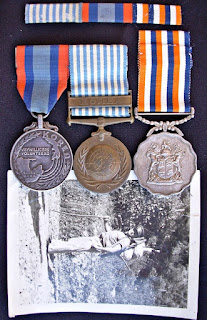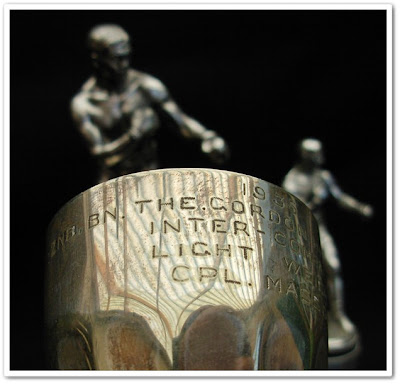LIEUT. WILLIAM MASSON MM, DFM
The Gordon Highlanders & Army Air Corps
WW2 Glider Pilot Regiment
MILITARY MEDAL (For Bravery in the Field)
DISTINGUISHED FLYING MEDAL (For Courage)
Military Medal, Distinguished Flying Medal, 1939/45 Star, Africa Star,
France & Germany Star, Italy Star, Defence Medal & KGVI War Medal.
William Masson
1st Battalion, Gordon Highlanders.
Two Decorations:
Military Medal & Distinguished Flying Medal.
MILITARY MEDAL
FOR BRAVERY IN THE FIELD
Naming on the MM
2874921 PTE. W. MASSON. GORDONS.
William Masson was awarded the Military Medal for escaping twice in very daring fashion.
Herewith a copy of Military Intelligence's Secret Report after the interview with Masson.
See the complete transcript after the scan.
INTERVIEWED BY M.I.9 24th FEBRUARY 1941
ACCOUNT OF ESCAPE OF
2818602 PTE. C. McIVOR. 1/GORDONS, 153 BDE. ,51 DIV
and
2874291 SGT. W. MASSON, 1/GORDONS, 51 (H.D.) DIV.
CAPTURED - 12.6.40 ESCAPE - 20.6.40
RECAPTURE - 20.6.40 FINAL ESCAPE - 12.7.40
1940, 12 June CAPTURE:
We were taken prisoners on 12 June with the remnants of our Battalion at ST. VALERY-EN-CAUX. We were marched off, in a long column of P/W, through OISEMENT to SOUES, where, we passed through the town, we escaped by jumping through an open doorway.
Soon afterwards we were given civilian clothes and set off for the coast.
1940, 28 June RECAPTURE:
We were picked up a week later at night by a German patrol near MOINCOURT, between CAYEUX and AULT, where we had been looking for a boat.
Unfortunately, for us, a German sentry had been shot that evening and, as we were in civilian clothes, we were accused of having done this. On interrogation we revealed our identity and were taken, next day, to ROUEN.
1940, 4 July ROUEN:
While under guard, at ROUEN, we heard two explosions, which we were told were caused by saboteurs. Later we rejoined other P/W with whom we were marched through CAMBRAI and TOURNAY towards BRUSSELS.
1940, 12 July FINAL ESCAPE:
On 12 July, when approaching Brussels, we dodged out of the column and, when out of sight as we were still in civilian clothes, set off again.
1940, 17 July CYSOING
12 August LINE OF DEMARCATION:
We then went through VICHY, THEIRS, LYONS, ST. ETTIENNE, LE PUY, MENDE, RODEZ, ALBI, TOULOUSE, FOIX, ARLES, AXLEC-THERMES and BOURG MADAM to the Spanish frontier where we were arrested by French gendarmes and, after detention at ST, CYPRIAN we were taken to FORT ST JEAN in MARSEILLES.
We saved up money (it took some time) given us by the American Consul and bought railway tickets to BANYULS, we crossed the frontier, assisted by three young gendarmes, over to COL DE BANYULS. We were arrested in Spain and spent eight weeks' detention in various prisons before release and repatriation.
(Interviewed by MI9 on 24th February, 1941)
DISTINGUISHED FLYING MEDAL
FOR COURAGE
Naming on the DFM
2874921 ACT W/O CL. II W. MASSON. A.A.C.
Preparing the Glider.
This Warrant Officer was a pilot in a glider-borne attack at Syracuse on the night of 9th July, 1943. Under circumstances of great difficulty and considerable enemy opposition, he succeeded in landing his glider in enemy territory without damage to the infantry men he was carrying. His skill as a pilot and his courage were an example to all. Subsequently, he displayed outstanding leadership and gallantry in an attack on a pill-box and was largely responsible for its capture. (From: WW2TALK)
Masson is also listed at PEGASUSARCHIVE - Invasion of Sicily - Five DFM's to Glider Pilots.
William Mason was born on 15 November 1912.
He is from Woodside, Bridge of Weir, Renfrewshire, Scotland.
Herewith a brief summary of his record of service.
Masson attested with the Gordon Highlanders on 17/11/1930. In 1941 he was decorated with the Military Medal for Bravery for his daring escape from German capture. He served with this unit until February 1942, both abroad (Gibraltar Garrison) and at home.
From there he was transferred to the Glider Pilot Regiment where he took active part in the Invasion of Sicily and was subsequently decorated with the DFM. He was promoted to Lieutenant and briefly held the rank of Temporary Captain towards the end of WW2. He was on strength with the Glider Pilot Regiment until December 1945.
The following is a letter confirming the transfer of
LT. MASSON, M.M.,D.F.M.
to the Territorial Army Reserve of Officers, The Parachute Regiment.
Also the promise of promotion to Honorary Captain the following year.
At this point he relocated to Tanganyika, East Africa.
Pte. Masson was physically very fit and a superb boxer, having won the Gordon's inter-company boxing champioships on numerous occasions. he fought as a Bantam & Light-weight.
The following is Masson's Asst. Instructor's Certificate.
dated 1933 - 1935
Herewith the inter-company boxing trophies which William Mason won
with the Gordon Highlanders during the 1930's.
1935
2nd Battalion, The Gordon Highlanders.
Inter-Company light Weight
Cpl. Masson
2nd Bn. The Gordon Highlanders. Inter-Coy Championship.
Winners 1931 "A" Coy - Bantam.
Pte. W. Masson.
Light-Weight Champion
Gibraltar Garrison
1934-35
Cpl. W. Masson
******************


























































